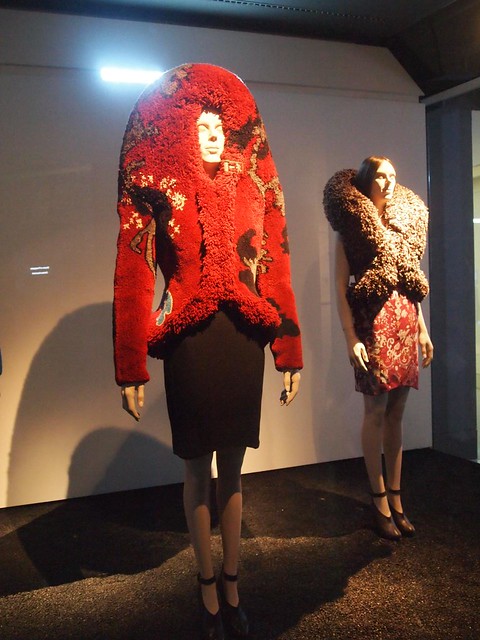Hussein Chalayan's work is characterized by an intellectual rigor and a quest for technical perfection (not just in clothes making techniques, he literally pushes technological boundaries), which often defies fashion conventions. He often uses his clothes as a medium to express his views on politics, social problems (such as war) and economic realities of the era. Hussein Chalayan was born in Nicosia in 1970, and graduated from Central St Martin's in 1993 and created his own fashion house just one year later. I really respect his designs because I feel that he overcomes fashion stereotypes (eg. that fashion is superficial) by incorporating research in anthropology, body anatomy, philosophy, architecture and science into his creative process.
The exhibition not only showcases his clothes, but a few short films which he produced on various subjects such as terrorism, DNA genome technology, subtle forms of violence in our daily lives and technology overtaking many aspects on man's life today.
This dress was presented for the first time in July 1993 at his graduation collection. He based the thesis of this collection, Buried Dresses, on the duality of spirit and matter by researching the works of Isaac Newton and Carl Gustav Jung. This dress was created with having iron filings thrown at magnetized clothing and then buried, his first combination of using unconventional means and technology to communicate ideas through fashion.
This collection was my first exposure to Hussein Chalayan's work as I was enchanted by how the model simply stepped into the circular table (photo above) and hooked the entire tabel onto her waist belt and converted it into a skirt in an instant. At that point in time I didn't understand what Chalayan was trying to say through this collection, I just thought it was an amazing mechanical trick - but this AW 2000 collection makes reference how Turkish Cypriots were subject to ethnic cleansing in Cyprus prior to the division of the island in 1974.
Staged in a minimalistic white room, the models appeared in seemingly simple clothes and proceeded to seize the objects in the room and fitting them into special pockets in their garments designed to hide them. In the final act, the models converted the chair covers into various shift dresses and packed up the chairs into wooden suitcases and then the final model converted the wooden table into a skirt and exited the set, leaving the white room completely empty and lifeless. Hussein Chalayan was trying to explore how the people affected by the war was hiding their possessions and carrying them while on exodus.
 |
| Blindscape, SS 2005 |
For this groundbreaking SS 2007 collection, Hussein Chalayan created a series of mechanical dresses which were able to morph from one era's style to another as a retrospective of fashion hisotry. I believe that in this circumstance, it really takes a genius to be able to sketch out all the silhouettes from the early Victorian ages to present to determine which are the elements that one era can borrow from another to physically morph the dresses.
 |
| Genometrics, AW 2005 |
 |
| Airborne, AW 2007 |
This collection was presented in four parts representing the four seasons to comment on how cycles of the weather had parallels with life and death of Man. The highlight was the video animation dress that was lit up by 15600 LED lights to represent summer. Again, Chalayan integrates technology in his designs by designing hats that glow red in the dark winter. It was a lovely transition between seasons and ultimately, he showed that clothes were still at the center of work in a series of parachute dresses that seemed to blow themselves up in the presence of wind. I stood in front of the display window for a good 20 minutes trying to observe the cut used and I still don't understand how he did it.
Whatever it is, I believe Hussein Chalayan will continue to be a force to be reckoned with in the fashion world - respected by people not only within the fashion industry for his talent and creativity, but also by non-fashion people to be someone who expresses his viewpoints on serious world/social issues through fashion. Named previously by Kar Lagerfeld to be THE designer he would like to see take over at Chanel, I believe he still possesses immense potential as both a designer and a vocal propagator of social issues (:








Thanks for sharing! I cannot describe how much I admire and love Hussein Chalayan's work! a true genius who not only makes beautiful dresses but is also an artist and above all a human being who connects ideas through his art. I remember seeing his SS2007 collection and thinking this was out of this world!! Even his new collection is really cool and a breath of fresh air despite its utter simplicity! Just love him!!!
ReplyDeletebonjour-singapore.blogspot.com